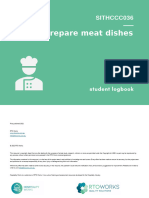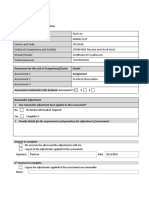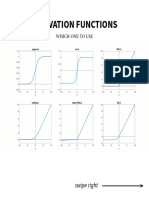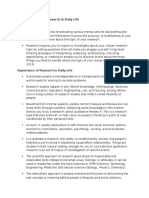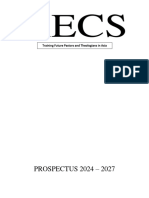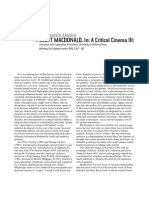SITHCCC042 Research Report
SITHCCC042 Research Report
Uploaded by
sarum awanCopyright:
Available Formats
SITHCCC042 Research Report
SITHCCC042 Research Report
Uploaded by
sarum awanCopyright
Available Formats
Share this document
Did you find this document useful?
Is this content inappropriate?
Copyright:
Available Formats
SITHCCC042 Research Report
SITHCCC042 Research Report
Uploaded by
sarum awanCopyright:
Available Formats
Research report
Culinary characteristics and ingredients of special, lifestyle, medical, allergen, cultural and religious diets
Complete the following table by providing a brief description of each diet or regime, the health or other implications of failing to address the special dietary
requirement, and at least one suitable adjustment, replacement or substitute ingredient.
Health/other implications
Characteristic/ Adjustment/replacement/
Description of failing to address
ingredient substitute ingredient
special requirements
Special lifestyle diets
Lacto ovo Includes dairy and eggs but excludes meat and fish. Inadequate protein intake, Plant-based protein
potential nutrient sources such as tofu,
deficiencies. tempeh, beans, lentils.
Vegetarian Excludes meat and fish but includes dairy and eggs. Iron and vitamin B12 Iron-rich foods like lentils,
deficiency, reduced protein spinach, fortified cereals;
intake. vitamin B12 supplements.
Vegan Excludes all animal products, including dairy, eggs, and honey. Risk of vitamin B12, iron, Plant-based sources of
calcium, and omega-3 fatty nutrients such as fortified
acid deficiencies. non-dairy milk, nuts,
seeds, and dark leafy
greens.
SITHCCC042 Prepare food to meet special dietary requirements 1
Health/other implications
Characteristic/ Adjustment/replacement/
Description of failing to address
ingredient substitute ingredient
special requirements
Pescatarian Includes fish but excludes meat. Potential mercury exposure Low-mercury fish options
from consuming certain like salmon, trout, or
fish. shellfish; plant-based
protein sources.
Low or no fat Limits fat intake for weight management or health reasons. Essential fat-soluble Use of non-fat or low-fat
vitamin deficiency (A, D, E, alternatives, such as skim
K), reduced satiety. milk, fat-free yogurt, or
lean cuts of meat.
High or low Emphasizes or restricts carbohydrate intake for various health goals. Imbalanced blood sugar For high-carb diets: whole
carbohydrate levels, energy fluctuations. grains, fruits, vegetables;
for low-carb diets: non-
starchy vegetables,
healthy fats, protein
sources.
High or low protein Focuses on increasing or decreasing protein consumption. Muscle loss or inadequate Lean meats, poultry, fish,
muscle repair (low protein), legumes, tofu for high-
kidney strain (excessive protein diets; vegetables,
protein). fruits, healthy fats for low-
protein diets.
Fad diets
SITHCCC042 Prepare food to meet special dietary requirements 2
Health/other implications
Characteristic/ Adjustment/replacement/
Description of failing to address
ingredient substitute ingredient
special requirements
Paleo Mimics the presumed diet of Palaeolithic humans, focusing on whole Nutrient deficiencies, Non-dairy calcium sources
foods and excluding processed foods, grains, and dairy. particularly in calcium, like leafy greens, fortified
vitamin D, and fibre. plant milk; vitamin D
supplements.
Raw Consists of uncooked, unprocessed, and often organic foods, believed to Risk of foodborne illness, Sprouted grains, nuts,
preserve nutrients. inadequate protein, and seeds; legumes, fruits,
calorie intake. vegetables.
Ketogenic High-fat, very low-carb diet aiming to induce ketosis for weight loss or Nutrient deficiencies Healthy fats like avocado,
medical reasons. (vitamins, minerals), keto olive oil, nuts; low-carb
flu symptoms, potential vegetables, moderate
long-term health risks. protein sources.
Macrobiotic Emphasizes whole grains, vegetables, and beans, with minimal animal Nutrient deficiencies Diverse plant-based foods,
products. (vitamins, minerals, incorporating various
protein), potential grains, beans, sea
imbalances. vegetables; supplements
as needed.
SITHCCC042 Prepare food to meet special dietary requirements 3
Health/other implications
Characteristic/ Adjustment/replacement/
Description of failing to address
ingredient substitute ingredient
special requirements
Flexitarian Primarily vegetarian but occasionally includes meat or fish. Inconsistent nutrient intake, Emphasis on whole plant
potential for foods, occasional lean
overconsumption of meat or fish, minimal
processed foods. processed foods.
Special medical diets
Type one and two Focuses on managing blood sugar levels through balanced carbohydrate Blood sugar fluctuations, Complex carbohydrates
diabetes intake. risk of complications (e.g., (whole grains, fruits,
heart disease, nerve vegetables), lean proteins,
damage). healthy fats.
Gluten free Avoids gluten-containing grains like wheat, barley, and rye. Nutrient deficiencies (Fiber, Gluten-free whole grains
B vitamins, iron), reliance (quinoa, rice), vegetables,
on processed gluten-free fruits, naturally gluten-free
products. proteins.
Dairy free Eliminates dairy products due to lactose intolerance or dairy allergy. Calcium, vitamin D, and Fortified non-dairy milk
protein deficiencies; (soy, almond), leafy
potential bone health greens, nuts, seeds,
issues. calcium-fortified foods.
SITHCCC042 Prepare food to meet special dietary requirements 4
Health/other implications
Characteristic/ Adjustment/replacement/
Description of failing to address
ingredient substitute ingredient
special requirements
FODMAPs Reduces intake of fermentable carbohydrates to manage digestive Digestive discomfort, Low-FODMAP alternatives
symptoms. nutrient deficiencies, like rice, potatoes, carrots,
restrictive eating patterns. certain fruits; moderation
and gradual reintroduction
of high-FODMAP foods.
Modified texture Alters food texture for individuals with swallowing difficulties (dysphagia). Risk of choking, inadequate Pureed, mashed, or soft
nutrition if textures are not foods; thickened liquids;
appropriately modified. specialized food
thickeners or additives.
Low or no salt Limits sodium intake for blood pressure management or kidney health. Electrolyte imbalances, Herbs, spices, citrus juices
potential iodine deficiency for flavouring; salt-free
(if not using iodized salt). seasoning blends; natural
salt alternatives like
seaweed.
Food allergens
Peanuts Avoidance of peanuts due to allergy. Risk of severe allergic Peanut-free alternatives
reactions (anaphylaxis), like sunflower seed butter,
potential cross- tahini; careful label reading
contamination. and avoidance of products
with peanut traces.
SITHCCC042 Prepare food to meet special dietary requirements 5
Health/other implications
Characteristic/ Adjustment/replacement/
Description of failing to address
ingredient substitute ingredient
special requirements
Tree nuts Avoidance of tree nuts due to allergy. Similar risks as peanut Nut-free alternatives like
allergy, potential for cross- seed butters (e.g., almond
reactivity. butter), pumpkin seeds,
sesame seeds.
Eggs Eliminates eggs due to allergy. Allergic reactions (ranging Egg substitutes
from mild to severe), (commercial egg
hidden egg ingredients in replacers, flax or chia
processed foods. seeds), applesauce,
mashed banana in baking
recipes.
Cow’s milk Avoidance of cow's milk due to lactose intolerance or milk allergy. Digestive discomfort, Plant-based milk
allergic reactions (varying alternatives (soy, almond,
severity). coconut), fortified with
calcium and vitamin D.
Fish Avoidance of fish due to allergy. Risk of allergic reactions Seafood-free alternatives
(ranging from mild to like tofu, tempeh, seitan;
severe), potential cross- careful label reading to
contamination. avoid fish-derived
ingredients.
Crustacea Avoidance of crustaceans (e.g., shrimp, crab) due to allergy. Similar risks as other food Shellfish-free alternatives
allergies, potential cross- like tofu, mushrooms,
vegetables; avoidance of
SITHCCC042 Prepare food to meet special dietary requirements 6
Health/other implications
Characteristic/ Adjustment/replacement/
Description of failing to address
ingredient substitute ingredient
special requirements
contact. dishes containing
crustaceans or their
derivatives.
Sesame seeds Elimination of sesame seeds due to allergy. Allergic reactions (varying Sesame-free alternatives
severity), hidden sesame like sunflower seeds,
ingredients in processed pumpkin seeds, tahini-free
foods. hummus; careful label
reading to avoid sesame
traces.
Soy or soy beans Avoidance of soy or soy products due to allergy. Allergic reactions (ranging Soy-free alternatives like
from mild to severe), chickpeas, lentils, black
hidden soy ingredients in beans; soy sauce
many processed foods. alternatives (coconut
aminos, tamari).
Cereals (or grains) Avoidance of specific grains (e.g., wheat, barley) due to allergy or Digestive discomfort, Gluten-free grains like rice,
intolerance. nutrient deficiencies if not quinoa, corn; alternative
adequately replaced. flours (almond, coconut)
for baking; careful label
reading.
SITHCCC042 Prepare food to meet special dietary requirements 7
Health/other implications
Characteristic/ Adjustment/replacement/
Description of failing to address
ingredient substitute ingredient
special requirements
Lupin Avoidance of lupin due to allergy. Allergic reactions (varying Lupin-free alternatives like
severity), potential cross- chickpeas, lentils, beans;
reactivity with other careful label reading to
legumes. avoid lupin-derived
ingredients.
Sulphites Avoidance of sulphites (used as preservatives) due to sensitivity or Potential allergic reactions Sulphite-free foods, fresh
allergy. (ranging from mild to fruits and vegetables,
severe), asthma homemade foods without
exacerbation. added sulphites; careful
label reading.
Special religious diets
Halal Compliant with Islamic dietary laws, which include specific methods of Religious non-compliance, Halal-certified meats,
animal slaughter and prohibitions on certain foods (e.g., pork, alcohol). cultural insensitivity. alternatives to pork
products (beef bacon,
turkey ham), alcohol-free
cooking ingredients.
Hindu May vary based on individual beliefs, but typically excludes beef and may Religious non-compliance, Vegetarian options,
avoid other animal products like pork. Some Hindus also avoid onions cultural insensitivity. avoiding beef and pork;
and garlic. onion and garlic-free
dishes for those adhering
to stricter practices.
SITHCCC042 Prepare food to meet special dietary requirements 8
Health/other implications
Characteristic/ Adjustment/replacement/
Description of failing to address
ingredient substitute ingredient
special requirements
Kosher Compliant with Jewish dietary laws, which include specific methods of Religious non-compliance, Kosher-certified meats,
animal slaughter and prohibitions on certain foods (e.g., pork, shellfish, cultural insensitivity. separate utensils and
mixing meat and dairy). cookware for meat and
dairy, avoiding prohibited
foods.
SITHCCC042 Prepare food to meet special dietary requirements 9
Food allergies, food intolerances and cultural and religious dietary sanctions
Complete the following table by providing a brief definition of each of the following terms and providing two examples of each.
Term Definition Examples
Food An immune system response triggered by consuming a particular food, often involving Ige 1. Peanut Allergy: Consumption of
allergy antibodies, leading to symptoms ranging from mild (hives, itching) to severe (anaphylaxis). peanuts leads to an immune system
reaction, potentially causing anaphylaxis.
2. Shellfish Allergy: Eating shellfish like
shrimp or crab can result in allergic
symptoms such as swelling, difficulty
breathing, or digestive issues.
Food Difficulty digesting certain foods, often due to enzyme deficiencies or sensitivities, leading to 1. Lactose Intolerance: Inability to digest
intolerance gastrointestinal symptoms like bloating, gas, or diarrhea. Unlike allergies, food intolerances do not lactose due to insufficient lactase
involve the immune system. enzyme, causing digestive discomfort
after consuming dairy products. 2. Gluten
Sensitivity: Non-celiac gluten sensitivity
results in digestive issues or other
symptoms after consuming gluten-
containing foods, without an immune
system response like in celiac disease.
Religious Dietary restrictions or guidelines based on religious beliefs and practices, often involving specific 1. Islamic Halal Dietary Laws: Prohibits
dietary foods or preparation methods deemed appropriate or forbidden according to religious teachings. consumption of pork and alcohol,
sanctions requires specific methods of animal
slaughter, and mandates avoiding
contamination with non-halal foods. 2.
Jewish Kosher Dietary Laws: Prohibits
consumption of pork and shellfish,
forbids mixing meat and dairy, and
SITHCCC042 Prepare food to meet special dietary requirements 10
involves specific rules for animal
slaughter and food preparation.
SITHCCC042 Prepare food to meet special dietary requirements 11
Key health and legal consequences of failing to address special requirements
Complete the following table by providing at least one health and one legal consequence of the following scenarios.
Scenario type Scenario Possible consequences
Allergic reaction A customer orders coffee and cake in a bistro during a busy weekend lunch service. At the Health consequences
time of ordering, they clearly state that they have an allergy to eggs and egg products and
check that the cake they are ordering is egg-free as advertised on the menu. The waiter
assures the customer that it is. When the waiter takes the order through to the kitchen, they Legal consequences
are careful to communicate to the kitchen staff that the customer has an egg allergy and they
write the allergy carefully on the docket. However, when the cake is served, a sauce
containing egg protein is added to the plate and it is served to the customer. The customer
suffers an allergic reaction requiring hospitalisation.
Anaphylaxis A resident in an aged care facility has a known allergy to tree nuts causing anaphylaxis. The Health consequences
allergy is clearly recorded in the resident’s medical records, in meal plans and as required by
all the legislation. However, there is a change to an ingredient in one of the sauces used in a
standard recipe which is not picked up when stock is delivered. The resident unfortunately Legal consequences
consumes a tiny amount of the sauce, suffers an anaphylactic reaction and passes away as a
result.
Food A person with a food intolerance to lactose is eating at a new restaurant. They forget to Health consequences
intolerance advise the staff about their dietary issue and, when the meal is brought to the table, they
notice that it has been topped with cheese. The addition of cheese wasn’t described on the
menu. They then advise the staff they have a lactose intolerance and ask them to return the Legal consequences
dish to the kitchen and prepare a new one. When the dish comes back to the table, the waiter
assumes that it is safe for them to eat. The next day, they suffer dietary symptoms similar to
having eaten lactose and the only thing that they can put it down to is the meal that they had
in the new restaurant. When they contact the restaurant, they discover that the cheese was
removed from the top of the dish and the same dish was re-served. The restaurant advises
SITHCCC042 Prepare food to meet special dietary requirements 12
Scenario type Scenario Possible consequences
the customer that there may have been some cheese throughout the dish as well.
Basic principles and practices of nutrition
Complete the following table for the seven nutrient groups and provide at least two examples of sources.
Nutrient group Definition Examples
Vitamins Organic compounds essential for normal growth, metabolism, Examples: Vitamin C (found in citrus fruits, strawberries, and
and overall health. They often act as coenzymes in metabolic broccoli), Vitamin D (found in fatty fish like salmon, fortified dairy
reactions. products, and sunlight exposure).
Minerals Inorganic elements essential for various bodily functions, Examples: Calcium (found in dairy products, leafy greens, and
including bone health, nerve transmission, and fluid balance. fortified foods), Iron (found in red meat, poultry, lentils, and
spinach).
Fibre Indigestible plant material that aids in digestion, promotes bowel Examples: Soluble Fiber (found in oats, fruits, and legumes),
regularity, and helps maintain a healthy weight. Insoluble Fiber (found in whole grains, nuts, and vegetables).
SITHCCC042 Prepare food to meet special dietary requirements 13
Nutrient group Definition Examples
Carbohydrates Primary source of energy for the body, including sugars, Examples: Simple carbohydrates (found in fruits, honey, and
starches, and Fibers. table sugar), Complex carbohydrates (found in whole grains,
legumes, and vegetables).
Fats Essential for energy storage, insulation, and hormone Examples: Saturated fats (found in animal products like meat
production. They are classified as saturated, unsaturated, and and dairy, as well as coconut oil and palm oil), Unsaturated fats
trans fats. (found in olive oil, avocados, nuts, and fatty fish), Trans fats
(found in processed foods like margarine and fried foods).
Protein Essential for building and repairing tissues, enzymes, hormones, Examples: Animal sources (meat, poultry, fish, eggs, dairy),
and antibodies. Composed of amino acids. Plant sources (legumes, tofu, tempeh, quinoa, nuts, seeds).
Water Vital for numerous bodily functions, including temperature Examples: Tap water, mineral water, fruits and vegetables with
regulation, nutrient transport, and waste removal. high water content (cucumber, watermelon, oranges).
SITHCCC042 Prepare food to meet special dietary requirements 14
Australian Dietary Guidelines
Complete the following table by providing a brief summary of each of the five guidelines included in the current Australian Dietary Guidelines. Ensure that you
use your own words. Include a source for your information.
Guideline Summary Source/s
Guideline 1 Eat a variety of foods from all food groups to ensure nutrient adequacy and health https://www.eatforhealth.gov.au/
benefits. guidelines/guidelines
Guideline 2 Limit intake of foods high in saturated fats, added sugars, and salt (sodium) for better https://www.eatforhealth.gov.au/
health outcomes. guidelines/guidelines
SITHCCC042 Prepare food to meet special dietary requirements 15
Guideline 3 Choose foods low in fat, particularly saturated fat, and choose healthier fats and oils. https://www.eatforhealth.gov.au/
guidelines/guidelines
Guideline 4 Eat plenty of vegetables, legumes, and fruits. https://www.eatforhealth.gov.au/
guidelines/guidelines
Guideline 5 Encourage, support, and promote breastfeeding; infants should be exclusively breastfed https://www.eatforhealth.gov.au/
until around six months of age. guidelines/guidelines
SITHCCC042 Prepare food to meet special dietary requirements 16
You might also like
- SITHKOP012 AT1 Research Report.Document22 pagesSITHKOP012 AT1 Research Report.Prabina Bajracharya100% (1)
- Assessment Task 1 SITHCCC036Document18 pagesAssessment Task 1 SITHCCC036Gaela KasangkeNo ratings yet
- Answer Sitxfsa008Document19 pagesAnswer Sitxfsa008teamromejamunaNo ratings yet
- A1 SITHCCC040 - Prepare and Serve CheeseDocument21 pagesA1 SITHCCC040 - Prepare and Serve CheeseSaruNo ratings yet
- SITHKOP012 Assessment 3 Workplace Assessments v1.1Document14 pagesSITHKOP012 Assessment 3 Workplace Assessments v1.1sabirvaidya0% (1)
- SITHCCC036 Student LogbookDocument17 pagesSITHCCC036 Student LogbookoffcialdjrobinNo ratings yet
- Market Research On Edible CutleryDocument20 pagesMarket Research On Edible CutleryVignesh Kg100% (5)
- Workflow Plan - Wedding MR & Mrs MillDocument1 pageWorkflow Plan - Wedding MR & Mrs MillReign Lim100% (1)
- TRANSFER CASE Final Drive Control Module (FDCM) - Electrical Diagnostics - Ram Pickup PDFDocument139 pagesTRANSFER CASE Final Drive Control Module (FDCM) - Electrical Diagnostics - Ram Pickup PDFcharlesNo ratings yet
- Transfert Case Getrag 760 PDFDocument47 pagesTransfert Case Getrag 760 PDFLê Văn HoạtNo ratings yet
- SITHCCC042 Task 1 QnADocument20 pagesSITHCCC042 Task 1 QnAChemistry SoniaNo ratings yet
- SITHCCC038 Student Assessment TasksDocument23 pagesSITHCCC038 Student Assessment TasksRameshNo ratings yet
- SITHCCC040 Student Assessment TasksDocument27 pagesSITHCCC040 Student Assessment TasksSujal KutalNo ratings yet
- Assessment-Task-1 SITHCCC037Document13 pagesAssessment-Task-1 SITHCCC037Gaela KasangkeNo ratings yet
- Paul Lee SITXINV001Assessment 1 - Receive and Store StockDocument14 pagesPaul Lee SITXINV001Assessment 1 - Receive and Store StockAndy LeeNo ratings yet
- SITHCCC040 Student Logbook - CheeseDocument12 pagesSITHCCC040 Student Logbook - CheeseSujal KutalNo ratings yet
- SITHPAT016 Student LogbookDocument22 pagesSITHPAT016 Student LogbookAnuska Jayswal100% (1)
- SITHCCC023 - Student LogbookDocument12 pagesSITHCCC023 - Student LogbookDj RobinNo ratings yet
- SITHCCC036 Student LogbookDocument12 pagesSITHCCC036 Student Logbookamanjohal431No ratings yet
- Samir MCS00001GZ Logbook SITHCCC012 Student Logbook 2Document15 pagesSamir MCS00001GZ Logbook SITHCCC012 Student Logbook 2Çrox Rmg PunkNo ratings yet
- SITHKOP012 Recipe Feedback TemplateDocument2 pagesSITHKOP012 Recipe Feedback Templatehelpdeskarea001No ratings yet
- SITHCCC040 Student Assessment TasksDocument25 pagesSITHCCC040 Student Assessment Taskshelpdeskarea001No ratings yet
- Sithkop010 Customer Preferences and Recipe Planning Template Uubd44bvDocument7 pagesSithkop010 Customer Preferences and Recipe Planning Template Uubd44bvtul Sanwal100% (1)
- SITHCCC028 - Student LogbookDocument34 pagesSITHCCC028 - Student Logbookmwc99fpf6hNo ratings yet
- SITHPAT006 Student LogbookDocument15 pagesSITHPAT006 Student LogbookRamesh AdhikariNo ratings yet
- 12 ReceipyDocument7 pages12 ReceipyteamromejamunaNo ratings yet
- SITXWHS007 Meeting Room Hazard Inspection Checklist (6498)Document6 pagesSITXWHS007 Meeting Room Hazard Inspection Checklist (6498)helpdeskarea001No ratings yet
- SITHKOP013 Food Supplies TemplateDocument2 pagesSITHKOP013 Food Supplies Templatehelpdeskarea0010% (1)
- Caf AssesDocument33 pagesCaf AssesMmc MixNo ratings yet
- Develop Menus For Special Dietary RequirementsDocument9 pagesDevelop Menus For Special Dietary RequirementsPahn Panrutai0% (1)
- SITXINV006 Student Logbook (Aman)Document12 pagesSITXINV006 Student Logbook (Aman)amanjohal431No ratings yet
- SITHCCC042 Preparefoodtomeetspecialdietaryrequirements Draft 20Document6 pagesSITHCCC042 Preparefoodtomeetspecialdietaryrequirements Draft 20Rupinder KaurNo ratings yet
- SITHCCC043 Workflow TemplateDocument8 pagesSITHCCC043 Workflow TemplatesasynshresthaNo ratings yet
- Sitxhrm 007 Student Assessment TasksDocument36 pagesSitxhrm 007 Student Assessment TasksRameshNo ratings yet
- SITHPAT006 Student Assessment Tasks 09-04-20Document33 pagesSITHPAT006 Student Assessment Tasks 09-04-20Ramesh AdhikariNo ratings yet
- Darwin Institute of TechnologyDocument33 pagesDarwin Institute of TechnologyYashaswi GhimireNo ratings yet
- SITHKOP012 Dietary Requirements Medical 4Document5 pagesSITHKOP012 Dietary Requirements Medical 4Ankit BhattraiNo ratings yet
- SITXFSA008 Food Safety Program Template.v1.0Document24 pagesSITXFSA008 Food Safety Program Template.v1.0etboite15No ratings yet
- Business Case Study TemplateDocument5 pagesBusiness Case Study TemplateBikash sharmaNo ratings yet
- WORKFLOW Plan of The LunchDocument1 pageWORKFLOW Plan of The LunchKaushal Pathak100% (1)
- SITHKOP015 Portfolio - Appendix 8 - Task 2 Template - StudentDocument1 pageSITHKOP015 Portfolio - Appendix 8 - Task 2 Template - StudentGun AceNo ratings yet
- SITXCCS015 Customer Record Sheet TemplateDocument2 pagesSITXCCS015 Customer Record Sheet Templategroverisha216No ratings yet
- SITHCCC023 Use Food Preparation Equipment - UKA ####DONE PRACTICALDocument12 pagesSITHCCC023 Use Food Preparation Equipment - UKA ####DONE PRACTICALravi patelNo ratings yet
- Assessment Task 2Document12 pagesAssessment Task 2Agus BudionoNo ratings yet
- PDF Unit 22 Sithccc005 Prepare Dishes Using Basic Methods of Cookery AssessmentDocument26 pagesPDF Unit 22 Sithccc005 Prepare Dishes Using Basic Methods of Cookery AssessmentMehedi Hasan RajibNo ratings yet
- SITHCCC042 RamanDocument22 pagesSITHCCC042 Ramangargniharika03No ratings yet
- Poultry FileDocument41 pagesPoultry FileYashaswi GhimireNo ratings yet
- Sith Pat 006Document6 pagesSith Pat 006Govind Rauniar0% (1)
- SITHCCC031 Prepare Vegetarian and Vegan DishesDocument14 pagesSITHCCC031 Prepare Vegetarian and Vegan Dishespravin chaliseNo ratings yet
- SITXCCS015 Complaints Register TemplateDocument3 pagesSITXCCS015 Complaints Register TemplateKajal KumariNo ratings yet
- SITHCCC037 Service Planning Template (1) Seafood DishesDocument16 pagesSITHCCC037 Service Planning Template (1) Seafood DishesSujal KutalNo ratings yet
- SITHCCC042 Student LogbookDocument59 pagesSITHCCC042 Student LogbookSujal KutalNo ratings yet
- SITXINV007 Assessment 1 - ProjectDocument16 pagesSITXINV007 Assessment 1 - Projectlouisa426wong100% (1)
- SITHKOP012 - Student Assessment TasksDocument31 pagesSITHKOP012 - Student Assessment Taskshelpdeskarea001100% (1)
- SITHCCC003 - AT2A of 3 - Food PreparationDocument6 pagesSITHCCC003 - AT2A of 3 - Food Preparationzamuel capalunganNo ratings yet
- 22 - SITHKOP015 - Appendix BDocument4 pages22 - SITHKOP015 - Appendix BStacy ParkerNo ratings yet
- SITHCCC011 - Written AssessmentDocument27 pagesSITHCCC011 - Written Assessmentsugunithakoyye35No ratings yet
- SITHKOP010 Student GuideDocument14 pagesSITHKOP010 Student Guideannykajcs011021No ratings yet
- Sitxinv002 Task 2Document20 pagesSitxinv002 Task 2Çrox Rmg PunkNo ratings yet
- SITHCCC018 Prepare Food To Meet Special Dietary Requirements by Tikaram Ghimire Apex 5000 DonDocument12 pagesSITHCCC018 Prepare Food To Meet Special Dietary Requirements by Tikaram Ghimire Apex 5000 DonTikaram GhimireNo ratings yet
- 11 SITHCCC013 Assessment Task 2 ProjectDocument13 pages11 SITHCCC013 Assessment Task 2 ProjectSneha DhamijaNo ratings yet
- SITHKOP010 Project Portfolio Task 2Document19 pagesSITHKOP010 Project Portfolio Task 2dhannaganessa9No ratings yet
- Redfern Station UpgradeDocument9 pagesRedfern Station Upgradesarum awanNo ratings yet
- Muswellbrook Bypass - New England HighwayDocument8 pagesMuswellbrook Bypass - New England Highwaysarum awanNo ratings yet
- SITHCCC041 Student Assessment PackDocument30 pagesSITHCCC041 Student Assessment Packsarum awanNo ratings yet
- SITHPAT016 Student Assessment PackDocument25 pagesSITHPAT016 Student Assessment Packsarum awanNo ratings yet
- CPCCCA3004 Assessment PRACTICALDocument71 pagesCPCCCA3004 Assessment PRACTICALsarum awanNo ratings yet
- Loadcell Transmitter PF-LBPDocument2 pagesLoadcell Transmitter PF-LBPhari mulyonoNo ratings yet
- Loans and Savings Management System For Bentuco National High School Faculty CooperativeDocument7 pagesLoans and Savings Management System For Bentuco National High School Faculty CooperativeInternational Journal of Innovative Science and Research TechnologyNo ratings yet
- SynopsisDocument9 pagesSynopsisvikas YadavNo ratings yet
- !!! E-Portfolio Assessment RubricDocument2 pages!!! E-Portfolio Assessment RubrickamaNo ratings yet
- ActivationsDocument8 pagesActivationsnitin gargNo ratings yet
- Basic Concept Method:: Flexural Stresses: Second Moment of Inertia, IDocument6 pagesBasic Concept Method:: Flexural Stresses: Second Moment of Inertia, IJeremiah VillanuevaNo ratings yet
- Stock ValuationDocument85 pagesStock ValuationArun kumar0% (2)
- Practitioner S Guide To Audit of Small Entities Revised 2020Document224 pagesPractitioner S Guide To Audit of Small Entities Revised 2020vijayNo ratings yet
- Lesson Plan - Shakespeare TableauxDocument8 pagesLesson Plan - Shakespeare TableauxXuan HanNo ratings yet
- Mix Design of Concrete: British (DOE) Method B. Bhattacharjee Civil Engineering Department Iit DelhiDocument20 pagesMix Design of Concrete: British (DOE) Method B. Bhattacharjee Civil Engineering Department Iit DelhiSidharth MahajanNo ratings yet
- Experimentalstudies On The Effects of Reduction in Gear Tooth Stiffness Lubricant Film Thicknessina Spur Geared SystemDocument13 pagesExperimentalstudies On The Effects of Reduction in Gear Tooth Stiffness Lubricant Film Thicknessina Spur Geared SystemBurak TuncerNo ratings yet
- Profesional ResumeDocument12 pagesProfesional ResumeMaulanaAhmadNo ratings yet
- Lehe Ledu Wildlife Zoo and ParkDocument13 pagesLehe Ledu Wildlife Zoo and ParkMaría MoncayoNo ratings yet
- Chicks Offer Insight Into Origin of FlightDocument16 pagesChicks Offer Insight Into Origin of FlightAlice CalviNo ratings yet
- Report TextDocument2 pagesReport TextIkhsanudin IchanNo ratings yet
- Desmodur 44V20L (описание англ.)Document2 pagesDesmodur 44V20L (описание англ.)Сергей ГороднийNo ratings yet
- Xamidea Human ReproductionDocument42 pagesXamidea Human Reproductionkeren spamzNo ratings yet
- Subic Bay Freeport Zone: State of The Mangroves inDocument6 pagesSubic Bay Freeport Zone: State of The Mangroves inJiggy MadrigalNo ratings yet
- Quiz QuestionsDocument5 pagesQuiz QuestionsShreeshNo ratings yet
- Crowd Management TextDocument17 pagesCrowd Management TextGeorge Trowbridge100% (1)
- Safety Suite Device Configurator-BrochureDocument4 pagesSafety Suite Device Configurator-BrochurePapaney VWNo ratings yet
- rESEARCJ REVIEWRDocument15 pagesrESEARCJ REVIEWRfelize padllaNo ratings yet
- 6061 Aluminium Alloy - WikipediaDocument33 pages6061 Aluminium Alloy - WikipediaMangesh MishraNo ratings yet
- 24 - AECS - Prospectus - 2024-2025 - Second - Draft FinalDocument38 pages24 - AECS - Prospectus - 2024-2025 - Second - Draft FinalsiemboiNo ratings yet
- BS en 13565-2-2018 (2019)Document50 pagesBS en 13565-2-2018 (2019)AntonijeNo ratings yet
- Martin Arnold Interviwed by Scoatt McDonaldDocument9 pagesMartin Arnold Interviwed by Scoatt McDonaldTomásVonDerOsten100% (1)
- 100 Soal Report TextDocument15 pages100 Soal Report TextMaya Sofianingrum75% (4)





